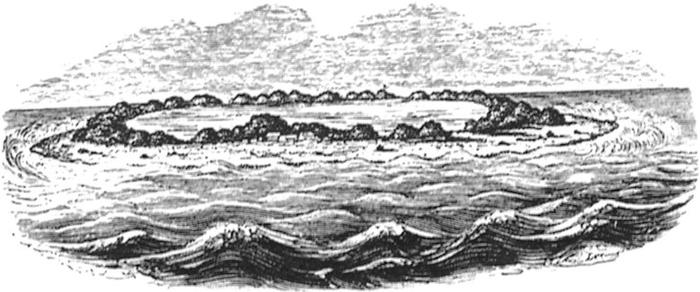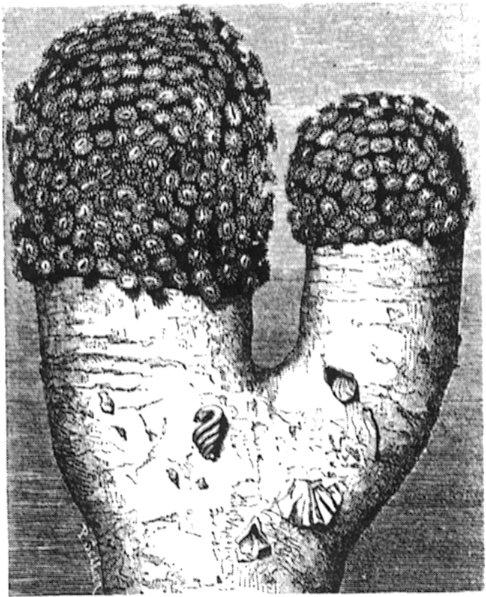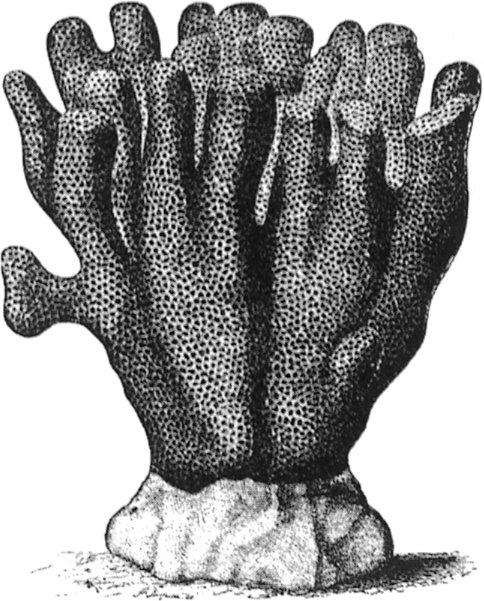Seven-Tenths (11 page)
Authors: James Hamilton-Paterson

Figures chosen by Darwin to illustrate his theory of coral-reef formation:

(i) A small island (Bolabola) surrounded by a barrier reef

(ii) A ‘lagoon island’ or atoll whose central peak has sunk, in this case (Whitsunday Island) leaving a rare example of a complete ring of land

(iii)
Goniopora columna

(iv)
Porites mordax
.
Coral was used variously as jewellery, medicine (ground up like mummy-powder) and inlays in cabinet-making. The precious red variety was traded for thousands of years without anyone being able to say precisely what it was. It was found in the sea, certainly, but fishermen and dealers were studiedly vague in order to protect their source. It presented a problem in the eighteenth century, however, since with the development of natural history it finally became necessary to say whether it was animal, vegetable or mineral.
Perversely, it exhibited characteristics of all three. At a time of industrious taxonomy this was unsatisfactory and exasperating. Coral reefs were notorious from the lyrical and often ambivalent accounts of sailors, who could one day view them as luxuriant herbaceous borders of surpassing delicacy and beauty, and the next as the most treacherous threat the tropical oceans could offer, ready at the first sign of a dozing lookout to tear the bottom out of a ship. The imagery used to describe reefs reflected this ambivalence; it also reflected confusion about the substance being dealt with. Horticultural images were common, and R. M. Ballantyne’s view of a reef in his novel
The Coral Island
(1858) as a sublime rock garden was by then almost a cliché, one of the two commonest ways of seeing coral. The other, somewhat later, was to view it as architecture. A reef was a fantastical cityscape, habitation for King Neptune and his courtiers (that is, when they were not housed in an Atlantean version of this kingdom, whose style tended towards Hollywood Athenian). Perhaps certain illustrations of science-fiction cities, in their lack of any unifying architectural style and their proliferation of bizarre organic shapes, derive ultimately from the iconography of reefs.
Until about 1750 zoophytes – that is, plant-like organisms such as anemones – were classified as vegetable. The very terminology
(animal-plant) reflected uncertainty. At that time ‘the animal’ was distinguished from the other class of living creatures as having the capacity to move at will from place to place. It was a long while before the agents responsible for coral were identified as zoophytes; but when they were, many saw them as vegetable since, like marine plants, they were attached to the substrate by disc or tubular fibres. What was more, the branching arms of coral looked convincingly arborescent.
This classification was challenged by mineralogists. They argued that many zoophytes were hard and stony, a description which fitted no known plant. Clearly they were rocks, made of calcareous and clayey sediments ‘moulded into the figures of trees and mosses by the motion of the waves, by crystallisation, by the incrustation of real fuci [seaweeds] or by some imagined vegetative power in brute matter’.
*
It was not for nothing that many reef-building corals became known generically as ‘madrepores’ or mother of stone.
The animal theory had its supporters, too. According to one of its proponents, Dr Vitaliano Donati, the ‘stone’ of coral was not stone at all, but
bone
. ‘I am now of the opinion, that coral is nothing else than a real animal, which has a very great number of heads. I consider the polypes of coral as the heads of the animal. This animal has a bone ramified in the shape of a shrub. This bone is covered with a kind of flesh, which is the flesh of the animal.’
†
It is an ingenious and eccentric idea. An animal in the shape of a shrub is – if nothing else – the exact opposite of topiary, and suitable for a zoological garden.
When reviewing these conflicting theories one might imagine the issue could have been settled once and for all by any naturalist spending a few hours with a good microscope. Yet a certain Henry Baker, in his book
Employment for the Microscope
(1753), could only see evidence for corals as mineral. According to him they were accretions of salts leached out of nearby rocks by seawater and bonding themselves chemically to ‘the calcareous and saline particles’ of the water. At the same moment a London merchant named John Ellis
began to use his microscope and came to different conclusions. Ellis was typical of a very English breed, the amateur naturalist, which was to flourish so valuably in the nineteenth century. Men with under-used intelligences and hours to fill would turn their attention to the fledgling sciences where there was still an immense amount of basic taxonomic work to be done, work which any dedicated amateur in quest of knowledge could perfectly well do. Country parsons were particularly given to this sort of hobby and alone accomplished field work and classification in a dozen disciplines including meteorology, geology, entomology, botany and ornithology. In addition to attending lectures at the Royal Society, Ellis, too, had a hobby. This was making miniature landscapes on sheets of paper with a collage of delicate fragments of seaweed and corallines. The more he used coral the more he wondered what it really was, finally putting it under his microscope. In 1752 he addressed the Royal Society, announcing ‘that these apparent plants were ramified animals, in their proper skins or cases, not locomotive, but fixed to shells of oysters, mussels, &c., and to Fucus’s’.
*
Carl Linnaeus, the celebrated Swedish naturalist and father of modern taxonomy, was impressed by Ellis’s work but nevertheless decided that zoophytes occupied a classificatory niche of their own ‘between vegetables and animals: vegetables with respect to their stems, and animals with respect to their florescence’. Ellis would have none of this and wrote to the great man that he could not reconcile himself to ‘vegetating animals’. He had a powerful sense of how things might partake of the characteristics of other things without fundamentally changing their nature. ‘Artful people,’ he wrote to Linnaeus, ‘may puzzle the vulgar, and tell us that the more hairy a man is, and the longer his nails grow, he is more of a vegetable than a man who shaves his hair or cuts his nails; that frogs bud like trees, when they are tadpoles; and caterpillars blossom into butterflies …’
†
In the mid-eighteenth century the Royal Society in London was to some extent the international arbiter of such things, and Ellis’s
view won more and more endorsement as correct. Many of the naturalists of the period had tried burning corals and found they obtained much the same smells and residues as from burning animal products such as skin, hair and bones. This seemed conclusive. After Ellis there was broad agreement that zoophytes, including corals and sponges, were indeed animal though there were some who, with Linnaeus, hedged their bets by preferring to think of them as ‘intermediate beings partaking of a twofold nature’.
*
This version of the dispute over corals turns out to be a very Anglophile account, implying as it does that it was all a matter of a handful of Britons working more or less in isolation. Such is not the case. Recent research makes clear it was a subject much discussed elsewhere in Europe a good half-century earlier, especially in France and Italy.
†
It reveals that it was actually a Frenchman, J.-A. Peyssonnel, who first identified the living part of corals as animal. In 1706 the Italian Luigi-Fernando Marsigli arrived in the French town of Montpellier, where he found ‘a thriving scientific community, serving the ancient university with its famous school of medicine and botanic gardens, a school of hydrography, and a Jesuit college’.
‡
Having collected corals, he performed all kinds of experiments on them. He would take branches home and put them in seawater of the same temperature as at the depth where they had been taken. The next morning he found them covered in little white flowers. He took the branches out of the water and the flowers vanished again. He put them back and they reappeared. Over the next few months Marsigli experimented with adding different reagents to the water to see what effect they had on the flowers. Excited by this discovery, he evidently cannot have known that the concept of the ‘flowers’ of coral was already familiar and had actually been illustrated in a medical treatise five years earlier. There, the author had thought coral was a marine stone which somehow grew.
In 1724 the son of a French friend of Marsigli’s became interested in these coral flowers and called on him. Jean-André Peyssonnel repeated all the older man’s experiments together with some of his own. His findings convinced him that what everybody thought of as a flower was actually ‘
un insecte
’ like a little octopus. He wrote a letter to the Académie des Sciences which was never published but whose ideas were later addressed by Réaumur and demolished in the lofty fashion of a grandee confronting the work of a junior. Réaumur declared that ‘what Peyssonnel had taken for animals living in a habitat of their own creation, analogous to the wax combs of bees, were merely insects infesting the coral stems … Réaumur himself believed coral to have a dual nature – a vegetable “bark” growing on a stony core.’
*
Snubbed, Peyssonnel waited until 1751 when he sent a copy of his
Traité du Corail
to the Royal Society in London. This was translated and extracts published in 1752, the year John Ellis addressed the Society with his own theory of corals being ‘ramified animals’. Peyssonnel had anticipated him by thirty years.
The idea that corals were not colonial invertebrates but a strange hybrid species lingered for a long time, and even the authoritative George Johnston a century later dissented with this view of sponges because they lacked polyps. He asserted they were plants and quoted in his support a certain Professor Owen writing in the
Lancet
: ‘If a line could be drawn between the animal and vegetable kingdoms, the sponges should be placed upon the vegetable side of that line. Locomotion could be no proof of animality; for it was well known that the sporules of some cryptogamic plants possessed very perfectly the power of motion.’
†
Even in the twentieth century some people still found the living – let alone animal – nature of corals hard to accept. Vice-Admiral Boyle Somerville records an instance when crew members of HMS
Penguin
, ordered to take soundings in the Kermadec Deep near Tonga, became obsessed with the beauty of some reef formations and went to great lengths to snap off and bring back several large chunks as souvenirs. These were winched aboard
the ship under the indulgent eye of the skipper (who had actually been in the old
Challenger
in the 1870s) and young Lt. Somerville. There is no indication that either of these men knew any better, and they seemed as surprised and disillusioned as their crewmen when after twenty-four hours in the ship’s hold the corals sent a stench of putrefaction throughout the vessel.
*
No doubt even today tourists by the thousand make the same error.
Susan Schlee suggests disarmingly that part of the reason why so many nineteenth-century oceanographers were fascinated by corals was that most of them came from cold, wet, northern climates and coral reefs are largely found in balmy, tropical and subtropical latitudes.
†
Once it was agreed that corals were animals, there was a new problem to be addressed, itself a promising field of research. This was, how could atolls have grown from the deep seabed when the reef-building polyps could not survive below about 200 feet? There was a suggestion that maybe they built on the lip around the craters of undersea volcanoes, but that left geology with the task of explaining how there could be so many volcanoes of nearly identical height, all of them conveniently reaching to within 100 feet of the sea’s surface.
There are three main kinds of coral reef: barrier, fringing and atoll. A barrier reef generally follows the coastline, often at a considerable distance, converting the sea between it and the shore to a shallow lagoon. A fringing reef is more like an extension of the land, and in place of a lagoon tends to have flats which may become partly exposed at low tide. An atoll resembles a roughly circular barrier reef, sketchily enclosing a lagoon. Even before the
Beagle
visited the only coral atoll of its voyage Darwin had evolved an elegant theory to explain how a coral atoll might be formed. He thought the process he described would apply equally well to barrier and fringing reefs since although the disposition of nearby land might be different, the principle had to be the same because of the constraints governing the life cycle of coral polyps. He took for
granted the truth of three assumptions: that corals needed warm shallow water in order to flourish, that parts of the Earth’s crust were sinking at a very slow rate, and that corals could grow upwards at least as fast as their substrate sank. The idea must have come to him as a result of finding marine fossils in the high Andes, of realising how portions of the Earth’s crust had in the past undergone considerable vertical movement and knowing there was no reason to think this process had stopped. This by itself was a radical idea at the time, as we know from the controversy Charles Lyell’s geological theories had provoked.
Darwin proposed a volcanic island poking up out of the sea to whose shallow inshore waters coral larvae drifted, forming colonies. In time these colonies merged and became a fringing reef more or less surrounding the island. The island itself, meanwhile, was sinking and obliged the corals to build upwards so as to remain in shallow water. Since the island was cone shaped it shrunk as it sank, producing an ever-widening lagoon around itself. The innermost corals, now cut off from the constant supply of nutrients in the open sea, grew no more, so that when the peak of the island finally disappeared it left a lagoon roughly surrounded by a ring of coral whose outer edge might extend straight downwards to a great depth as successive generations of polyps had built on their defunct predecessors. In this way, the coral ring of an atoll marked the original outline of a vanished island.
This neat theory of Darwin’s was contested, notably by the Scottish oceanographer John Murray. After the sudden death in 1882 of Charles Wyville Thomson, who had led the
Challenger
expedition in the 1870s, Murray took over the job of publishing the expedition’s immense report. He had been on the
Challenger
himself and was very struck by the sediment samples which revealed far greater precipitation than he had imagined. He now thought Darwin’s theory too complicated and too dependent on crustal movement. Instead, he proposed that the calcareous remains of plankton, falling on undersea mountains in a steady drizzle over the millennia, built up a layer of compacted sediment reaching to within 200 feet of the surface, at which point the coral larvae started their colonies.
In order to explain the atoll’s characteristic shape Murray somewhat weakly suggested that this was simply the normal pattern of growth for coral colonies. Trees grew into tree shapes, corals into atolls.